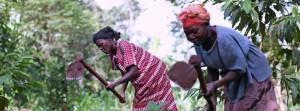Government neglect of agriculture raises concerns

The hoe remains the leading implement and it is women who use it the most as plans to modernize agriculture are limited by inadequate funding.
June 12—Renewed concern has been raised over the government’s continued financial neglect of the agriculture sector despite it being the backbone of the economy, but is still allocated less than 10% of the annual national budget outlay.
“We have a competitive advantage over the other East African countries, because we have half of the fertile land that can grow any food or cash crop in Uganda and yet countries like Kenya and Rwanda continue to perform better in agriculture than us. This is mainly because the farmers are incapable of using the available land to increase production,” Patrick Mweheire, the Stanbic Bank Chief Executive said during a budget review hosted by Uganda’s biggest financial institution. In 2016, Stanbic Uganda reported deposits of UGX3 trillion.
Uganda is a signatory to the 2003 Maputo Declaration that bound African governments to commit 10% of the their annual national budgets to agriculture development. The sector employs most of Uganda’s workforce but its contribution to GDP has been steadily declining from the highs of 70% in the early 1990s to 30% today with gains being seen in services and manufacturing.
Out of a total budget of UGX29 trillion (around $8 billion), agriculture is to get just under UGX 863.4 billion during the 2017/18 financial year or about 3%. Although allocations to the sector have been rising, according to many critics not fast enough to make a meaningful impact. During FY 2016/17, agriculture was allocated UGX 823.42 billion which was a 60% increase compared to FY 2015/16.
Last year, the World Bank in a report said almost two thirds of the agricultural income growth of households is attributable to high commodity prices (explained in part by sound policies) and favourable weather. Nonetheless, it was not driven by the adoption of modern farming techniques and practices.
Mweheire told guests, who included senior officials from the public and private sector, that Uganda’s agriculture sector is under-performing, because the majority of rural farmers are unable to access resources that will make them more productive. He said 50% of the fertile land in the whole of East Africa is in Uganda and yet the country continues to be the least productive in agriculture with often cases of people going hungry.
He said,“Seventy percent of the farmers are subsistence farmers who cultivate on their small acres of land hence producing food only for consumption with some very little left to be sold. These people do not have the capacity to rent land or even the capacity to cultivate the large scale farms in case they have the land. That’s why we are asking government to concentrate on the large scale farmers so that they can be able to utilize the available land and increase production. The other small farmers can benefit directly from the large scale farmers.”
Adam Mugume, the Executive Director, Research at Bank of Uganda said, the projected growth of a 6% GDP during FY 2017/18 that the government is working towards will not be achieved unless it refocuses on the way agriculture production is handled.
“We are under-producing compared to our projected capacity. We are an agricultural country, but we are still importing juice from countries that do not even have land. Even when there is market for our producs, we are unable to supply constantly, because there is underproduction. Government needs to refocus, instead of supplying seeds to farmers who will eat them or plant them on the dry land, it’s better to focus on the commercial farmers by modernizing the agriculture sector and giving financial access for them to be able to produce more. Later on, when the sector is grown, we can think of bring everyone on board,” Mugume said.
Mugume said although Uganda is strategically located and peaceful, its foreign direct investment (FDI) has fallen off compared to Kenya and Rwanda. Uganda’s GDP is currently at 3.4% a drop from the previous levels of 5% and above. Poor agriculture production has been cited as a major reason in the aftermath of an extended dry spell in 2016.
The World Bank thinks low agricultural input can also be linked to the low quality of inputs prevalent in local markets—on average, 30% of nutrients are missing in fertilizers available to farmers in local markets. It is also be related to the fact that for technology adoption to pay off, it must be complemented by access to credit and access to markets.

 African Heads of state head to South Korea next week for Summit talks
African Heads of state head to South Korea next week for Summit talks
 Trading leads as main source of income for Ugandans
Trading leads as main source of income for Ugandans
 New leadership for bankers’ umbrella as total assets top $12 billion
New leadership for bankers’ umbrella as total assets top $12 billion
 Brussels Airlines to announce Nairobi service
Brussels Airlines to announce Nairobi service
 SITA promises enhanced travel experience after Materna acquisition
SITA promises enhanced travel experience after Materna acquisition
 Saudia’s 105 aircraft order stretches A320neo lead over rival Max
Saudia’s 105 aircraft order stretches A320neo lead over rival Max
